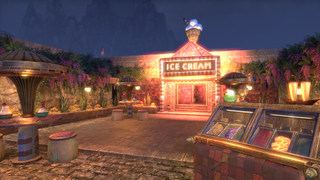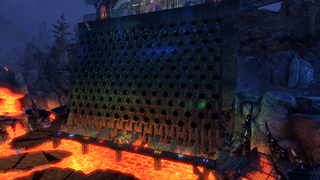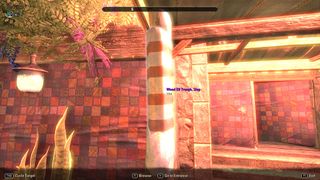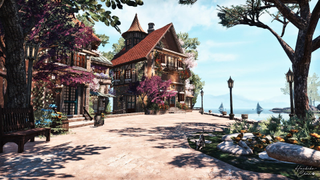The Elder Scrolls Online is having its 10th birthday this week—to celebrate, I was invited to have a chat both the game’s creative director Rich Lambert, as well as several players deep in the housing community’s paint.
To be clear, I haven’t played this game since 2019, but I’ve always been sinking time into at least one MMORPG. World of Warcraft, Final Fantasy 14—I even had a surprisingly-long stint on the now-official City of Heroes private server, Homecoming.
Despite being super familiar with how incredibly creative these communities are, though, ESO’s housing artists still managed to surprise and delight me—which is mostly owed to the game’s hands-off, chill attitude towards clipping objects into each other. A form of digital sculpting the community’s affectionately named “cobbling.”
The art of the cobble

Nordenheim, a Twitch streamer and overall Elder Scrolls Housing enthusiast, is showing me around an ice-cream parlour built by Futerko. “That candy cane striping?” he says, directing me to the darling little barbershop sign out front. “That is literally a wood elf trough of slop, but just turned to only show the candy-cane.”
Every base I’m shown has the same kind of ingenuity powering it: Beds shunted into the ground to form casino tables, a warhorn turned on its side next to an inverted, clipped candle to represent a spilled ice cream. I’m even told there’s a “giant pachinko machine” that fully works, though that’s on a different region’s server. He was kind enough to send me a screenshot, though:

“It’s just your creativity and imagination. That’s the only limit,” I’m told. Under any circumstances, I’d be sceptical—but staring at these builds? I’m starting to believe that might genuinely be the case. Limitations exist, sure, but limitation is the mother of creativity.

Every peek behind the curtain only impresses me further. To be clear: these mosaics aren’t just premade assets slapped together on grids. ESO players have honed the art of smashing models into each other to, essentially, sculpt entirely new models like 3D mosaics. To demonstrate this, Nordenheim pulls apart a tree he’s created right in front of my eyes, which feels like watching someone huck their Lego Death Star at a wall just to see it explode.
The game has this neat mechanic in housing areas—if you press F5, your cursor will tell you what objects you’re looking at, giving you a proper appreciation for just how complex some of these builds are. I assumed one oak tree was a premade asset, until I activated my newly-acquired gamer vision and realised it was like, 50 logs, just… folded into each other.
“There’s a lot of creative professionals who actually joined the housing community just because of the sheer creative aspect of the game … we have illustrators and architects and all sorts who end up diving into the [system]”, Nordenheim explains.
I also spoke with Futerko, a housing enthusiast and Youtuber responsible for that trough-powered ice cream sign. She also happens to create some beautiful stuff, like this fairy landscape complete with wise ents. “I’ve never before encountered a game with such freedom in building,” she tells me. “Cobbling in this game is unprecedented. What you can create is practically infinite, of course, as long as you have an idea for it!”
One of her favourite personal builds, an underwater house called “Into the Unknown,” sports statues of both Poseidon and a giant Hydra—which are similarly cobbled together from spare assets, forming a sum greater than their parts. “Constructing the stone effigies of Poseidon and the Hydra from scratch proved to be a nice challenge,” she writes, which feels extremely humble considering what I’m looking at.
Another housing maestro by the name of Hachiko Chan focuses more on cosy, residential areas inspired by Japanese architecture—creating time lapses so prospective builders can fully appreciate the work that goes into them. “I personally like to recreate the illusion of Japanese-style doors and windows by combining beds and lanterns. Or soft sofas and armchairs, simply using stools and grain bags.”
The radiant beauty of cherry blossom trees 🌸#ESO #ESOFam #ESOhousing #TESOnline #Japan pic.twitter.com/DAFusQs1JnMarch 29, 2024
Hachiko similarly credits the game’s cobbling freedom as the thing that got her hooked: “A vast choice of objects, furniture and trophies, not to mention the system that allows us to combine and move around the house as we please. These elements provide us with the tools necessary to imagine and create surprising cities, sculptures or skyscrapers starting from nothing.”
‘Surprising’ is the word. Each of these players sent me screenshots of their (or their friends’) pride and joy—art murals, forest groves, and even just straight-up Howl’s moving castle, all assembled piecemeal with game asset scrap. I legitimately have too many to show them in their entirety, so I’ll just be scattering image galleries through the rest of this piece. Browse at your leisure.
Each one of these players spoke of ESO’s housing community in glowing terms. “This whole community of supportive creator folks has formed around one aspect of the game,” Nordenheim tells me, as I stare agog at a hand-crafted city district with tucked-away cafes. “It’s become this huge thing.”
All of this enthusiasm, however, doesn’t just spawn from the community. The choice to let players cobble assets together was a very deliberate one on the developer’s behalf, as creative director Rich Lambert explains.
“Yeah, we’re good with it. Let ’em go.”

“We spent a long time early on—even before launch—talking about what housing could be, what it should be, how it should work,” Lambert tells me on a video call. “There was a concern of ‘well, if you give players 100% creative freedom, they’re gonna put chairs on the ceiling and they’re gonna stick them in walls, that kinda stuff. Ultimately, it came down to: ‘let em!’ If they want to create something silly, let ’em do that.
“We were just like: Yeah, we’re good with it, let ’em go.”
For Lambert, supporting these maverick desires has been the point all along—even when it comes to addons, which have a mixed history in the genre. Final Fantasy 14, for example, prohibits them entirely, while World of Warcraft’s been struggling with the arms race between programs like WeakAuras and the game’s actual raid design.
As long as they want to mess around in houses, we’re gonna continue to add to the system and improve it.”
Rich Lambert, Creative Director
ESO’s got its own addon woes to deal with, I’m sure, but when it comes to housing Lambert says the team’s a lot more relaxed. “You’re isolated to your house—there’s an addon called magic carpet,” a mod which, Lambert explains, lets players just fly around their homes by rapidly placing and replacing an asset below their feet. No need for scaffolding: “It doesn’t hurt anything outside of the house, so we’re okay with that kind of stuff.
“Our UI engineer spends a lot of time in the mod community working with addon authors … sometimes addon authors want to do things we don’t want addons to be able to do, and we have to shut that kind of stuff down—but it’s a really good dialogue, and most of them really understand.”
That’s not to say that ESO’s housing system is completely unlimited. There is a cap on the amount of assets you can flood a building with, though Lambert maintains that’s mostly due to technical limitations.
“We’re trying to find more ways to get more types of assets in homes and in larger quantities, but players will absolutely fill them so full that they’ll crash every time they go into them … you’re really digging into ‘how much memory can you have’, and making it so if you blow memory, bad don’t things happen—it’s those kinds of problems we’re trying to solve.”
In the interest of fairness, I do also want to point out here that ESO does double your furnishings limit if you’re an ESO plus member, though I figure if you’re dedicated enough to housing for that to actually matter, asking for a subscription to a game you’re plugging dozens of hours into is reasonable.
The technical limit Lambert’s talking about here is also based on that doubled number—and from what I understand, you can’t really pay for extra furnishing space. Ultimately: “As long as they want to mess around in houses, we’re gonna continue to add to the system and improve it.”
MMO magic

I’ve given a pretty glowing impression of ESO’s housing system here, and that’s mostly because of how passionate the players have been. Their enthusiasm was infectious in the way any good, earnest enthusiasm is.
I’d be remiss, however, if I didn’t point out that this kind of dedicated fanbase wasn’t unique to any one MMO. Heck, I’ve seen similarly incredible builds on City of Heroes private servers—and that’s a game that was literally shut down years ago. I’m also not going to speak to the rest of the game’s quality—I had a brief love affair with it in 2019. It hit stuff, I did quests, it was a good time.
However, these glowing words surrounding ESO’s housing system (straight from the mouth of its enthusiasts) and the strong community springing up around it? It does speak to the developers’ making, as Nordenheim puts it, “the smartest choice they could’ve made.” If you give players a sandbox, they’ll do things you never even anticipated.
The Elder Scrolls Online has some grey in its beard. But if housing systems are your thing, it’s definitely a game I’d at least check out. The housing community is passionate and creative in a way that elevates an older MMO—and that’s exactly why I think the genre has staying power, even if we’re having a bit of a slump with new releases.

